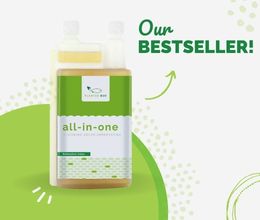Algae growth is a common issue in freshwater aquariums. When your tank is overrun by aquarium algae, it leads to poor water quality, reduced visibility, and potential harm to aquatic life. It can quickly cover plants, hardscape, and glass, making tank maintenance challenging. Regular algae removal through scraping and siphoning is necessary but can be time-consuming and labor-intensive. Personally, the less work with cleaning the better! 🙂
Fortunately, Mother Nature has a clever way of keeping stubborn algae in check – certain algae eating aquarium fish and invertebrates naturally feed on algae, offering a welcome solution to this growing problem. By adding “clean-up crew members” that are considered algae-eating species, you can have a healthy aquarium, maintain a thriving ecosystem, lessen the stress on your setup. These natural algae eaters can help preserve a clean and clear aquarium, allowing you to focus on enjoying your tank instead of constantly battling algae growth in your aquarium.
My personal top 5 of best algae eaters for your aquarium
Maintaining an algae-free planted tank can be a challenge. However, some species can assist in this effort. Some fish and invertebrates are known to feed on common types of algae found in freshwater aquariums. These species can be a valuable addition to a planted tank. Below are my five favourite (and best) algae eaters that can help with algae control, along with brief descriptions and care information!
Algae eater #1: Bristlenose Pleco (Ancistrus cirrhosus)
The Bristlenose Plecostomus, commonly known as the Bristlenose Pleco or Ancistrus, is a fantastic addition to any larger freshwater aquarium, especially for those looking to keep algae under control. These small, armored algae eating catfish are easily recognizable by the bristle-like appendages on their snouts, which become more pronounced as they age. Unlike many of their pleco relatives, Bristlenose Plecos remain relatively small, typically maxing out around 12 centimeters, making them suitable as algea eaters for aquariums of mimimum 100 liters.
Bristlenose Plecos are known for their peaceful temperament, preferring to spend their time grazing on algae or hiding amongst driftwood and rocks during the day. They are nocturnal, so you’ll often find them more active after the lights go out. Their diet should be primarily vegetarian, consisting of algae, plant-based wafers, and the occasional blanched vegetable like zucchini or cucumber. However, a small amount of protein, such as sinking pellets or live food, can help keep them healthy and vibrant.
Breeding these algae eaters is also relatively straightforward, with males taking on the primary role of caring for the eggs. A well-maintained tank with plenty of cave-like hiding spots and a consistent feeding schedule will increase your chances of a successful spawn. If you’re looking for a hardy, algae-eating companion that doesn’t require extensive care, the Bristlenose Pleco is an excellent choice.

Important parameters to keep Bristlenose Pleco
- Minimum volume of aquarium: 100 liters
- Temperature: 18 – 30° but ideally between 24 and 28°
- pH: between 5.5 and 7.6
- GH: 1 – 14
- Light: low to medium
- Water circulation: normal
Algae-eating shrimp: Amano shrimp (Caridina multidentata)
Amano shrimp are one of the top choices for aquarists looking to control algae in their tanks naturally. Known for their efficiency, these shrimp tirelessly scavenge for algae and detritus, helping to keep the aquarium clean. They are known to eat most types of string and hair algae, such as the commonly found green hair variety.
In addition to their cleaning capabilities, Amano shrimp are incredibly resilient. They thrive in a variety of water conditions but prefer stable environments with plenty of plants as they prefer to hide in nooks and crannies around your tank. Due to their easy-going nature and low care requirements make them a popular addition to community tanks. This particular algae-eating shrimp is quite resilient and is one of the better shrimps you can include in your cleanup crew. However, aside from needing lots of hiding places, they only need the occasional omnivore pellets or wafers for their diet. If you’re looking for a kind of shrimp that can help you eliminate string and hair algae, you’ll find no better shrimp than this algae eater.
One important thing you might want to know is that it’s safe for you to place 6-8 of these in your tank without them over breeding because they only do so in brackish water. You also need to ensure they have enough places where they can safely molt because they are typically vulnerable after that.

Important parameters to keep Caridina multidentata
- Minimum volume of aquarium: 50 liters
- Temperature: 12 – 26°
- pH: between 6.8 and 8
- GH: 5 – 20
- Light: low to high
- Water circulation: normal
Siamese Algae Eater (Crossocheilus oblongus)
Siamese Algae Eater (Crossocheilus oblongus) is highly valued for its excellent ability to control algae in aquariums. This fish is considered a continuous grazer, feeding on various types of algae, including stubborn ones like black beard algae (BBA), which other fish leave alone. This species is know for its constant foraging on plants, decorations, and even glass surfaces. This keeps algae growth in check, ensuring a cleaner and more visually appealing aquarium. They are slim and elongated, with a distinctive black stripe that runs along their body from head to tail.
Siamese Algae Eaters are active swimmers and thrive in groups, which helps minimize stress and territorial aggression that can develop as they age. One thing to note is that these algea eating aquarium fish are initially sold when they are small so they can start out in 120-liter tanks but since they grow up to 15cm long, you might need to plan ahead when they get too big.
They do best in well-maintained aquariums with enough swimming space, good water flow, and plenty of plants, which not only provide grazing surfaces but also simulate their natural habitat. It’s crucial to keep the tank covered since these fish are known to jump. Aquarists seek a natural solution to keep their aquariums clean, which makes their peaceful nature compatible with a variety of tank mates but their primary appeal is their efficiency in controlling algae.

Important parameters to keep Crossocheilus oblongus
- Minimum volume of aquarium: 200 liters
- Temperature: 24 – 28°
- pH: between 6 and 7.5
- GH: 8 – 12
- Light: low to high
- Water circulation: low to high
Smallest algae eater: Nerite Snail (Neritina natalensis)
Known for its exceptional algae-eating abilities, the Nerite Snail (Neritina natalensis) is a highly regarded addition to aquariums. These snails are known to consume a variety of algae types, including stubborn forms like green spot algae, brown algae, and even black beard algae, which makes them particularly valuable for keeping tanks clean. Their constant grazing on surfaces like glass, decorations, and plants helps to maintain a clear and visually appealing environment in the aquarium.
These algea eating aquarium snails have attractive and diverse shell patterns and are small, typically measuring between 1 and 3.5 cm in length. Their shells require hard water to remain healthy and thrive in freshwater environments with stable pH levels. Despite their effectiveness, it’s important to ensure they have enough algae to eat, as they can starve in tanks with insufficient food. Supplementing their diet with algae wafers or blanched vegetables like zucchini can help.
One of the benefits of Nerite Snails is that they do not reproduce in freshwater, meaning they won’t overpopulate your tank. However, they can lay eggs that do not hatch unless specific brackish water conditions are met. For aquarists looking to avoid excessive snail populations, they are a low-maintenance alternative.

Important parameters to keep Neritina natalensis
- Minimum volume of aquarium: 20 liters
- Temperature: 22 – 26°
- pH: between 7 and 8.5
- GH: 8 – 20
- Light: low to high
- Water circulation: low to high
Borneo Sucker (Gastromyzon punctulatus)
The Borneo sucker is a freshwater fish that has gained popularity among aquarists for its longevity, vibrant coloration, and distinctive patterns. These fish naturally feed on algae and biofilm in their environment, and they exhibit the same behavior in aquariums.
They are often observed clinging to rocks or glass, grazing on algae, which helps in controlling algae growth within the tank. They thrive in cool, oxygen-rich, and fast-moving waters that mimic its natural habitat. Although Borneo suckers have specific aeration needs that can make them challenging to keep, they are generally hardy and easy to care for.
These peaceful and interactive algae-eating fish are often seen clinging to rocks or glass in the tank, where they relax or feed on algae and biofilm. While male Borneo suckers might engage in the occasional tussle, these interactions rarely cause harm so you have nothing to worry about.
In the wild, they live in clusters, so it’s advisable to keep them in groups of at least four in an aquarium setting. Despite their social nature, Borneo suckers are also shy and may hide behind filter media, decorations, or plants. Their unique behavior and appearance make them an intriguing addition to any aquarium.

Important parameters to keep Gastromyzon punctulatus
- Minimum volume of aquarium: 75 liters
- Temperature: 20 – 24°
- pH: between 6 and 7.5
- GH: 8 – 12
- Light: low to high
- Water circulation: medium to high
Conclusion
Choosing the right algae eater is crucial not only for maintaining a clean and healthy aquarium, but also in order to add diversity and activity to the aquarium. Regardless of whether you choose the industrious Amano Shrimp, the efficient Siamese Algae Eater, or the robust Nerite Snail, each of these creatures will add a unique value to your aquatic ecosystem. Understanding the specific needs and behaviors of both plants and fish will assist you in creating an aquarium that is both balanced and thriving.
The right algae eating crew will not only prevent algae growth, but will also contribute to an aquarium’s overall beauty and harmony. If you’re already on the lookout for these algae eaters, have you checked if your aquarium is missing anything? Check out my products at my shop.








